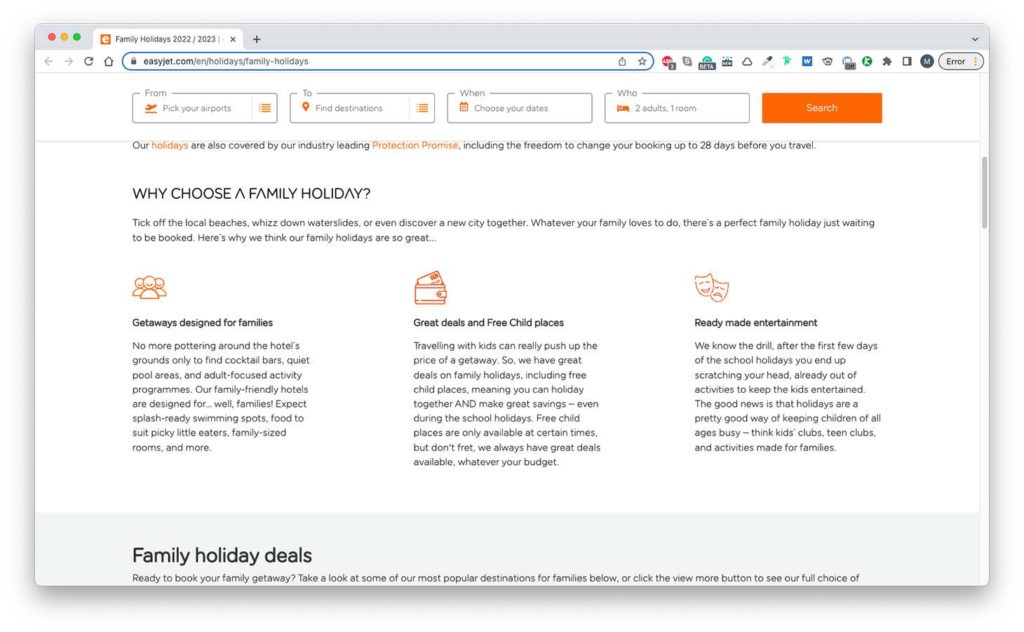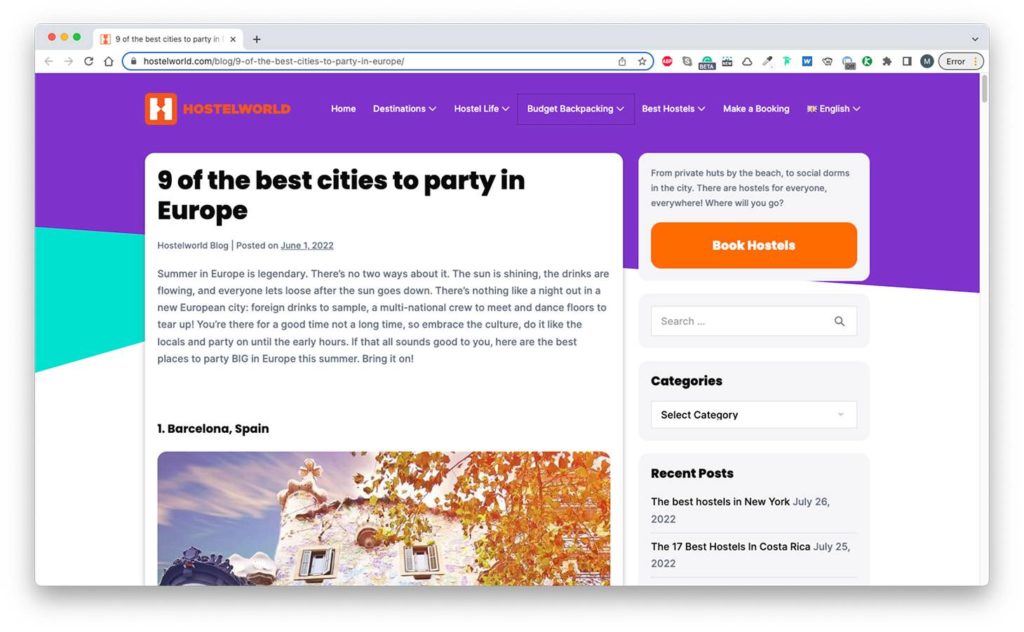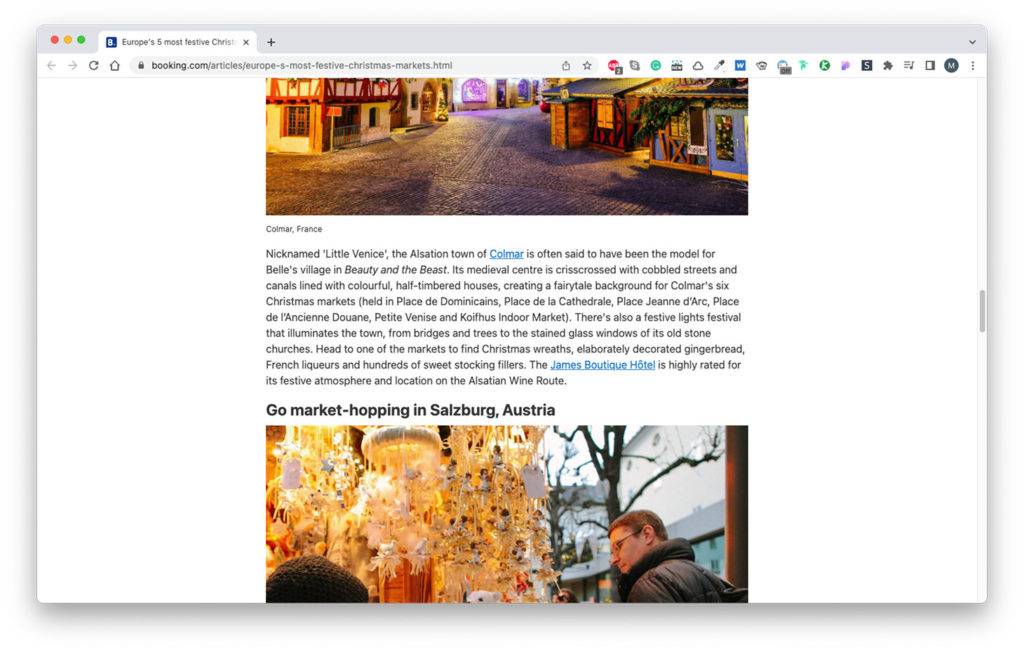Why is good copywriting important for the travel industry?
Quality copy has the power to influence readers at every stage of the consumer funnel and ultimately drive them towards conversion.
But, in this oversaturated travel market, your copy not only needs to be high-quality but also has to address customer pain points in a voice that they can relate to.
To achieve this, there are two main things you need to do before you can start writing:
1. Find your niche
To be able to write in a voice your readers can relate to, you need to identify what expectations your ideal audience might have when interacting with your brand and how your offering is going to meet them. Do you appeal to students searching for exciting but cheap holidays? Or, is your brand more suited to the traveller looking for a luxury experience complete with all the amenities?
Once you’ve done this, spend some time getting to know this audience. Research the current landscape – what are competitors doing? What’s trending on social media? – and see where your offering fits in. You should also look at what kinds of things your target audience is searching for and responding to online.
Be aware that how you used to profile your audience may have changed since, as different groups have different demands in a world of post-pandemic travel. For example, student travellers previously seeking budget-friendly breaks may now be more open to luxury travel experiences, having not travelled for several years and maybe even having saved up the money for these more high-end experiences.
All of this groundwork will give you a good indication of how to tailor your content to your niche.
2. Develop your tone of voice
Once you’ve decided on your niche within the travel industry, you can start to build your brand’s tone of voice (TOV) and create unique content that speaks to your specific audience.
Your TOV is the way you communicate your values and who you are as a brand through your choice of words, communication style and emotional tone. This is different from your brand voice, which is your brand’s unique perspective and the values you stand for. Your TOV should convey your voice and values.
Having a clear TOV will help you build a connection with your audience, foster trust in your brand and ultimately boost conversions. It’ll also help you stand out in an oversaturated market and convince consumers to book their travel with you over a competitor.
If you want a little extra help in identifying and developing your brand’s tone of voice, get in touch to find out how our copy department can support with TOV and Branding.
How does all of this look in practice?
Once you’ve identified how you meet your audience’s pain points and your tone of voice as a brand, the next challenge is working out how to convey all of this to your customers through your written content. Let’s look at some examples:
Easyjet offers a great travel writing example, showing how a brand can use its copy to speak to a specific audience.

It’s obvious that this copy is from the family holidays section of the site; not only is it full of references to children and families, but the copy itself is also family-friendly, addressing the pain points of that specific audience, like cost and the need to “keep the kids entertained”.
The language is also casual, accessible, and most importantly, empathetic – ideal for the family traveller looking for an easy solution to planning a trip during the school holidays. Phrasing like “we know the drill” and “we always have great deals available, whatever your budget” demonstrates how the copy (and therefore the brand) acknowledges and sympathises with the specific needs of Easyjet’s target family audience.
Hostelworld provides another good travel writing example, demonstrating how a brand uses its copy and tone of voice to solidify brand image and secure customers.

When it comes to brand identity, this blog introduction leaves nothing to the imagination – it’s clear who the target audience is, what the brand is offering and how it meets their needs and wants. The TOV is also fun and playful, just like the target traveller.
Mastering intent: creating travel copy with a purpose
As mentioned, good copy is instrumental in guiding users down the funnel and driving conversions. Quality copy can do this because, alongside answering audience pain points and affirming brand identity, it has a clear intent behind it. Every piece of content on your website should have a clear purpose, and identifying the intent behind your pages will help you tailor the way you create content and provide the most value for readers at every stage of the funnel.
In the travel industry, customers at the awareness stage may be seeking more detailed, experiential content, such as blog posts or landing pages about specific locations or holiday types. The purpose of content at this stage is to broadly showcase how your brand and offering will meet audience pain points and inspire the reader to respond, ideally by staying on your site and moving down the funnel. Alternatively, someone who is ready to book their holiday may expect shorter content that provides them with essential information, making conversion as easy as possible.
When it comes to matching intent, something else to bear in mind is seasonality. Seasonal trends present a complex content challenge – how do you make sure your content targets peak seasons without being irrelevant for the rest of the year? This task is further complicated when you have finite resources for copy and content creation.
Creating evergreen content is key for maintaining relevancy year-round. But, in order to target peaks like those caused by school holidays or local festivities, you’ll still need to create specific seasonal content. You need to strike a balance.
By keeping content that targets the lower half of the funnel evergreen, you can enjoy the best of both worlds – seasonal content at the top of the funnel will drive people to your site and evergreen consideration/ evaluation-focused content will help keep them there and lead to conversions.
With all these considerations in mind, don’t forget to also maintain TOV throughout your copy. As already highlighted, this will give your content that extra boost and can even contribute to increased conversations.
Let’s look at another example:
This excerpt is taken from a Booking.com blog about ‘Europe’s 5 most festive Christmas markets’ and is a great example of a brand being mindful of both intent and seasonality. The copy on this page is ideal for an inspiring awareness or evaluation-stage blog post; the use of descriptive and sensory language helps you picture yourself there and makes you want to book your visit.
Additionally, alongside being clearly seasonal, this page links out to more evergreen content on Booking.com’s site, namely a page listing hotels in Colmar and the landing page for the ‘James Boutique Hotel’, both of which are more evergreen and more conversion-focused. The balance has been reached. Seasonal content has been created to draws the reader in and internal links to evergreen booking pages have been added to nudge them down the funnel.
4 tips for writing great travel copy
Content that lines up with user intent and speaks to your niche with a distinct tone of voice is a good starting point, but when it comes to actually writing copy for the travel industry, there a few more things to think about.
Here are four ways to improve your travel copy and make it exceptional:
1) Be specific
An all-too-common feature of travel writing is vague, generalised copy.
Your on-page content needs to showcase your brand – what you’re offering, what your values are, why customers should choose you – and you can’t do that with generic copy. Instead, use your content to shout about the specifics of the destinations, hotels or tours you offer to draw readers in and help move them along the funnel.
Let’s look at an example of a luxury travel company offering tours in France:
Enjoy a unique tour that gives you the chance to explore the best of French food and culture.
This copy is bad because:
Instead, do this: From robust cheeses to rich croissants, sample the best of French cuisine on a bespoke foodie tour through Paris. We’ll take care of all the transport and accommodation so all you need to do is sit back and dig in.
This copy is better because:
2) Paint a picture
When you last booked a tour or hotel, you probably didn’t choose it because lunch was included or because it had air conditioning. While these are important considerations, most people will make their final travel decision based on the experience that’s being sold to them.
Don’t waste words listing the amenities of a specific hotel, tour or holiday package on an awareness or consideration stage page – save these facts for a conversion-focused booking page. Instead, use experiential copy to flesh out the details and show readers why your offering is unique and special.
Here’s an example of some copy for a seaside spa hotel:
Enjoy a room with a sea view and 24-hour room service when you book in advance at this hotel.
This copy is bad because:
Instead, do this: At this hotel, you can wake up to the sound of the sea outside your window and start your day of relaxation with breakfast in bed, brought to you by our room service team, whenever you choose.
This copy is better because:
3) Do your research
Whether you’re a small brand or a big player in the industry, research is fundamental to producing good travel content. Speak to experts both inside and outside of your company and learn everything you can about the destinations, packages or services you’re writing about. It’s obvious when a piece of content hasn’t been well-researched, so it’s worth putting in the time before you start writing.
Let’s look at a travel writing example for a Japan destination landing page:
Japan is a fascinating country, with many great destinations to visit, including Mount Fuji, Tokyo and Kyoto.
This copy is bad because:
Instead, do this: Japan is a fascinating country with many great destinations to visit. Take a scenic boat ride on lake Kawaguchi at the base of Mount Fuji, wander through the night markets in Tokyo or enjoy a traditional tea ceremony in Kyoto – the choice is yours.
This copy is better because:
4) Avoid clichés
We’ve spoken a lot about getting your copy to stand out from the crowd, and another easy way to do this is to stop using classic clichés in your travel writing. While it’s easy to do, using clichés is another way of being vague about your brand and services – they say nothing about your specific offering.
A great way to avoid falling into the cliché trap is to focus on providing detailed, sensory descriptions. Let’s look at an example of a gap-year travel brand talking about visiting different destinations in Costa Rica:
Visit Guanacaste for powdery beaches and sparkling blue water.
This copy is bad because:
Instead, do this: At Tamarindo Beach in Guanacaste, you can sink your toes into golden sand as you watch the surfers rolling through the blue waves. Looking for a bit of adventure? Get your wetsuit on and give it a go yourself at one of the local surf schools.
This copy is better because:
Maximising your travel content
After you’ve spent all that time improving the quality of your travel writing, there are some simple ways you can maximise the impact of your copy and make your content shine.
- Add an author byline – highlighting the author of blog posts and longer-form pieces will boost E-A-T (Expertise, Authority and Trustworthiness), which influences organic rankings.
- Incorporate keywords – weaving target keywords naturally throughout your content will do wonders for your organic results. Just make sure that your targeted keywords (and your written content in general) are unique to every page to avoid cannibalisation.
- Focus on internal linking – this is another easy way to boost your travel copy, showing Google how the pages of your site link together and provide value for a reader.
- Include high-quality visual assets – choose eye-catching images relevant to the destination or service you’re writing about to sell the dream. But, remember that you still need good copy to convey all the relevant information; while an inspirational video of The Great Wall of China might make you want to travel there, only written copy can give all the details of the Chinese tour holiday your brand offers.
- Use strategy to back up your content – A clear underlying strategy will ensure that all your copy is written with a purpose, with clear intentions that inspire action. Our Content Strategy team are on hand to help you lay these foundations and give your copy a stand-out quality before words are even on the page.
If you’re looking to make your travel content stand out after the years of restrictions and disruptions, investing time and money into creating exceptional, unique copy can do wonders for your brand. With the right foundations and execution, great travel copy can set you apart from competitors, foster trust in your brand and ultimately boost conversions.
If you’d like more travel writing tips or want to learn about constructing a foolproof strategy to back up your travel copy and content, get in touch to find out how our Copy and Content Strategy teams can help you.








